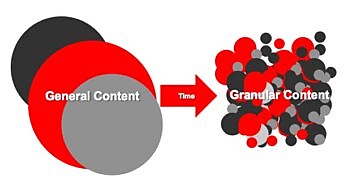We seem to be reaching the saturation point for posts about how content marketing is reaching the saturation point.
The after-shocks caused by posts like Mark Schaeffer’s Content Shock (over 600 comments and counting) and our own perplexingly runaway Crap slideshare, indicate that marketers are terrified by the idea that content marketing is reaching its End Days.
I don’t want to be the guy who said the high-risk mortgage market (and the Taj Mahal of shitty securities built on top of it) couldn’t possibly collapse. But if content marketing does lose its mojo, it won’t be because people ran out of bandwidth and our attention-pipes got clogged with content.
If our capacity to consume content was really the critical constraint here, we would have hit Schaeffer’s content shock when the world’s published books exceeded any individual’s capacity to read. That happened sometime in the 1500s.
I’m sure there were people back then who ran down the mean medieval streets shouting, “We’ve reached knowledge saturation!”. But they were as wrong as all the nut-cases throughout history who called the specific date of the apocalypse (there’s an amazingly long list of them here).
There are two big reasons that general content saturation should be way down on our worry list (somewhere between being hit by lightning and being hit by Groundskeeper Willie):
1) The world is always changing
Content interprets the world for an audience. And the world – and everything on it – never stands still. Even if you’re in a business as dodderingly mature as lift trucks, the market you’re producing content for today is dramatically different from the market you swam in two years ago.
Change creates content vacuums and it’s our job as marketers to fill them.
2) Content will inevitably become increasingly granular.
One of the things the Internet is airbag-deployingly great at is identifying and serving niche interests. Not just niches like ‘banjo players’ but nano-niches like ‘clawhammer banjo players who like Irish fiddle music and Jimi Hendrix’ (a nano-niche of which I am a proud member). (I should probably go back and change ‘proud member’ but I won’t: feel free to giggle).
So, after 355 words and one junior-high-level double entendre, I finally come to the point of this rambling post:
Hey content marketers: it’s narrowcast time.
If yesterday, you wrote whitepapers with titles like, “Computers in The Public Sector”…
Today, you’re cranking out eBooks with titles like, “Hadoop vs SQL for Local Government Big Data Processing Initiatives”…
And tomorrow, you’ll be producing interactive scrolling sites with titles like, “The CFO’s Guide to Hadoop MapReduce Tactics for Compliant Citizen Tagging, Tracking and Deleting.”
(I sincerely hope your own life is at least marginally more glamorous than this, but mine ain’t far off).
It’s like those über-groovy fractals that reveal more and more detail the closer you zoom in. The key idea is pretty simple:
The granularity of our interests is nearly infinite.
And if you add the dimension of time and the inevitability of change, it is infinite.
In content marketing, relevance is a function of specificity. (Go on, tweet that sucker. I’ll wait.)
Your mission, should you choose to accept it* is to zoom in.
In fact, it’s kind of unavoidable.
As B2B content marketers, we deal in issues.
And, if we’re really authorities on our subjects, every issue opens up into more granular issues with specific spins targeted to increasingly tight audiences.
Your content marketing programs will probably start with some big-picture, top-of-the-funnel pieces. But if you’re doing your job right, it will quickly become more and more targeted.
In our work for the world’s most amazing and surprisingly nice tech companies, we see it happen over and over again. We start with big content pillars that establish the world view of our client. We then snap off hot issues that the target audience is obsessing about right now. Then we start spinning these stories to different vertical markets, company sizes, job titles and (our favourite) psychographics.
As the content gets more granular, the numbers go down. Fewer people read them.
But the value of each reader is dramatically higher than the more general content used to fill the top of the hopper.
Let’s face it, when someone downloads “The CFO’s Guide to Hadoop MapReduce Tactics for Compliant Citizen Tagging, Tracking and Deleting”, it behooves all good salespeople on the Public Sector/CFO/Hadoop beat to pick up the bloody phone.
Granularity boosts relevance.
Relevance boosts engagement.
Engagement boosts conversion.
Conversion boosts your ability to trade in your battered porkpie hat for that Philip Treacy you’ve had your eye on.
No content shock in that.
The not-so-great news: granular content is harder to produce than general content.
You have to know your stuff.
You have to be inside your market every day.
You have to have an almost pathological addiction to learning new things.
The good news: granular content is harder to produce than general content.
So lazy marketers will shy away.
And your overpaid competitors will lean back just as you’re leaning in.
Advantage: yours.
Bottom line: The Singularity is so over. Here comes The Granularity.
Five, no six, tips for going granular
Six for the price of five:
Get writers up to speed and keep them on board.
You can’t switch to new writers every time you do a piece. Invest in making your writers subject experts.
Develop a methodology for hoovering up expertise from others.
Do not leave this to chance. Other people are critical to granular content. Build a repeatable method for sucking out their brains and pumping the greyish liquid into content.
Put the experts in the spotlight.
Your best customers, partners and in-house gurus aren’t just sources, they’re stars. Feature them. Interview them. Make them famous.
Atomise.
Take your mother-ship content and give it granular, highly targeted spins. For different verticals, disciplines, regions and psychologies. We talk this a lot in The B2B Content Marketing Strategy Checklist. You might like it.
Think micro.
Granular content does not have to be a 40-page eBook. It can be the content marketing equivalent of a haiku.
Cross-promote.
Each piece of granular content should promote the other pieces – and the mother-ship. That means going back and revising old pieces so they promote later ones. (a pain in the arse but SO worth it).
I’m afraid there really isn’t a silver bullet here. Just, as Ben Horowitz likes to say, lead ones.
But lots and lots of lead bullets can take down an awful lot of prospect gazelles.
[Note to self and everyone eavesdropping on conversation with self: replace bullet metaphor with something less macho and NRA-friendly].
So:
Got any experience with or thoughts about narrowcasting?
The comment zone below awaits.
——————————–
* Did the Mission Impossible guys ever say, ‘Nah.” to that?

Enjoyed this article?
Take part in the discussion








Comments
Fiona Campbell-Howes May 11th, 2014
Oh man, I have so many thoughts about this! Definitely a trend we’ve seen building with the various clients we work with. So many people are doing ‘content’ that it’s only the stuff that’s really specific to a particular business problem being experienced by a particular person at a particular point in time that’s going to get through.
The trick (obviously) is identifying what those problems are and creating content that hits them on the head. That’s why it’s important for marketers and writers to talk regularly to a) customers and b) salespeople – they’re the ones who really know what the audience is obsessing about.
We’re also starting to see this trend being taken to its logical conclusion. One step beyond “The CFO’s Guide to Hadoop MapReduce Tactics for Compliant Citizen Tagging, Tracking and Deleting” is “Bill Perkins’s Guide to Hadoop MapReduce Tactics for Compliant Citizen Tagging, Tracking and Deleting.” We’re seeing some marketers taking a completely personalised approach to content creation – actually creating completely bespoke content for a specific organisation or individual, based on what that organisation or individual has said its/their issues are. That takes a huge amount of research, writing and investment – but if you can get just one $1m+ deal out of it, it’s all worth it.
Lastly, as a writer, I find hyper-specific content *much* easier to write than generic content. With generic content you lose sight of who you’re writing for (because your client has said it needs to target everyone – from the CEO to the field service engineer), so it’s hard to stay focused. There are so many messages, it’s hard to create a coherent argument or narrative. And there are usually so many ‘stakeholders’ reviewing and signing off that the thing goes through loads of rounds of amends. Really specific content about a really specific topic for a really specific persona is way easier – as long as (as you say) you can get to grips with the topic and communicate it well.
I’m v. excited about this move to more granular content – it means we (writers) have an opportunity to create really good, really useful stuff. Nothing worse than spending days slogging through some terrible generic white paper that ticks a box for your client but deep down you *know* no one will want to read it!
Doug Kessler May 11th, 2014
Great response, Fiona. I do think personalisation is the natural destination for all this.
As a writer, I really like getting granular too. But there’s a big overhead: getting the input you need. I also like big-picture stuff but it’s best whan the big ideas are based on insights from the granular work.
Barry Feldman May 11th, 2014
With the exception of the big circles to small circles diagram at the top, this is one brilliant essay. I nominate Kessler for the little circle “funny, philosophical, strategic, creative” niche inside oversized circle content marketing non-niche.
Alessio Madeyski May 11th, 2014
Love this post.
One thing that is totally underrated when we talk content is : USEFUL. Really, it’s so simple but so underrated I cannot explain.
The other day I was in a restaurant website. The website was well done, and with a lot of sections like menus, photos and all that. But you know what it wasn’t there? The opening hours! I mean, the opening hours. The only information I need from that website was not there. I picture them getting excited to have a website full of crap missing out the important information every customer is looking at.
I became fan of granularity. Like with books: rather than reading a Rolling Stone top 100 rock band post, I prefer to read a 400 pages biography of Brian Eno and David Bowie. You know what I mean?
I think you HAVE TO be granular especially if you work to create content in-house. You need to know everything regarding your company, and produce useful content. You are selling a software? Create content covering all (and I mean ALL) the aspects of that software. I don’t care about an infographic about “the best 10 software out there”, especially if you are not solving my problem. Tutorial, videos, real-time and personal customer service…there is so much to cover you have a content calendar from here to eternity. Let’s not necessarily be creative just because everyone is telling you to. Creative means a person who creates something. Let this something be useful.
Doug Kessler May 12th, 2014
Thanks for the comments, Bazza and Allessio.
@Bazza: What’s wrong with the big circles to small circles?!
Maybe a tad…. literal?
But I gratefully accept the micro-niche you assigned me.
(:-)) [That there is what happens when you try to put a smiley emoticon inside parentheses.
@Alessio
Utility — absolutely! And for me, granularity increases utility.
Especially for your real prospects (not just the tyre-kickers).
James Byrne May 13th, 2014
I couldn’t agree more with you Doug on this, ( your point on Schaeffers content shock made your point very well, have to use that ) however, I fear your suggestions are too much of a challenge for a lot of brands. Just taking a granular look at their audiences seems to be enough of a challenge even if big resources and dedicated team is in place.
Great suggestion about speaking to customers (particularly unhappy ones) and sales people should be a given before you even look at SF Cloud, Adobe and the rest of the vendors who provide great depth to colour a more granular and personalised piece of content.
Interested in Banjo and Hendrix – can a left-handed stringed banjo player play on a right-handed stringed banjo?
Doug Kessler May 14th, 2014
Thanks James.
Great question! You can’t really string a 5-string banjos for lefties (that weird, short string on top). You’d have to build a custom one.
If Hendrix had stayed with us, he’d have had one built by now.
Andy Detweiler May 24th, 2014
Doug,
Great take here. Really enjoyed it.
Always makes me chuckle when people talk about too much content (your reference to the 1500s was spot on). I think what really scares people is not that there will be too much content. But that just publishing every day will not be enough anymore to achieve any meaningful marketing goals (as it has been for so long).
The most evident example of this is the marketing industry, of course. How many “why content marketing is like — insert pop culture reference here” articles can be written before folks say enough is enough? How many times can someone write an article about how often to post a blog if they aren’t offering a new take? Sure, that may be the most common question people ask, but it doesn’t mean that writing a blog post about it will be the most helpful. What would be the most helpful is referring them to the sources that have already thoroughly explored the topic. Eventually, this will spread to most other industries (it already has to a large degree, I’m sure).
IMO, what has made content marketing so powerful up until this point is not only that the content has been helpful, it’s also been DIFFERENT in terms of tactic. As soon as everyone is doing something, it no longer holds the value it once did.
Doug Kessler May 31st, 2014
Agreed Andy. Following is no way to stand out. With content marketing, you can’t really opt out these days — but you can do it differently.